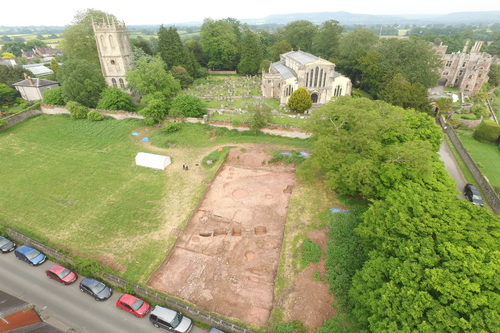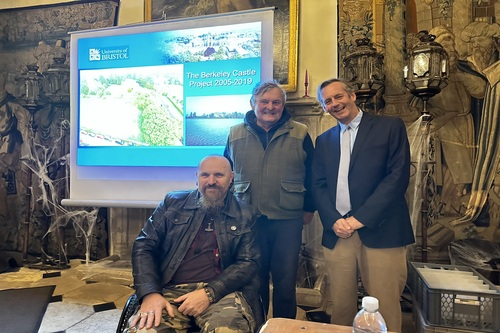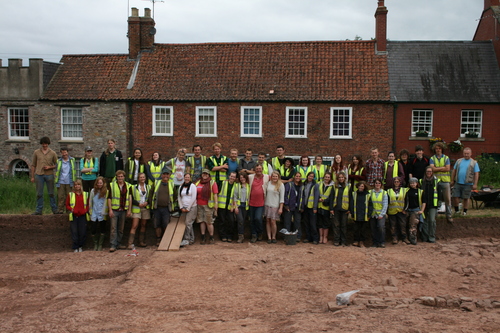
Ariel shot of the site University of Bristol

Dr Stuart Prior [left] with Professor Mark Horton [centre] and Charles Berkeley [right] at the book launch event University of Bristol

Group shot of students and staff at the site University of Bristol
A new book has been published which follows the partnership between the University of Bristol and the Berkeley Castle Estate in South Gloucestershire where 15-years of archaeological excavations have unearthed forgotten treasures and greatly enhanced understanding of the area's rich history.
Berkeley Castle Tales was launched earlier this week. It is edited by Drs Stuart Prior and Konstantinos Trimmis from the University's Department of Archaeology and Anthropology and Professor Mark Horton, an emeritus of the department who is now Pro Vice-Chancellor for Research and Enterprise at the Royal Agricultural University.
The project, which in 2016 won the prestigious Current Archaeology award for the Archaeology Project of the Year, was formed in 2003 in light of proposed development and heritage conservation work in and around the town and its famous castle.
Over the years various TV shows have featured the work including the BBC's One Show, Countryfile and Flog It. The team were joined by Professor Alice Roberts in 2019 when Digging for Britain filmed the final series of excavations.
In 2003, the then Castle Director approached staff at the University's with the offer of a long-term research project with the aim of serious academic research being carried out on the castle and its environs.
The project began with an initial visit by the late Professor Mick Aston, Professor Mark Horton, and Dr Stuart Prior, and the first season of fieldwork at the castle was conducted in 2005. This subsequently turned into a 14-year archaeological research project for students from the university, surrounding schools and colleges, summer schools, and local volunteers of all ages until the final season of excavation by the university in the summer of 2019.
From the outset the objective was to build up a detailed picture of the history and archaeology of the castle and the town of Berkeley by combining the results of detailed archaeological fieldwork with information contained in the castle's impressive collection of 20,000 historical documents; 6,000 of which relate specifically to the medieval period.
Dr Prior said: "It was anticipated that the project, on such an important, prestigious and largely undisturbed site, would add to our knowledge and understanding of the early medieval period and subsequent changes in landscape and society with the coming of the Normans, and the erection of a castle on the former Saxon site."
Some of the key findings and discoveries included:
- The remains of an Anglo-Saxon minister thought to date back to the 9th century and destroyed sometime between 1019 and 1051.
- Pottery and a millstone from the late 9th to early 11th century – associated with the minster.
- An Anglo-Saxon silver halfpenny of King Edgar (the Peaceable) 959–975; the Great Great Grandson of Alfred the Great.
- The remnants of two fishponds and a building which may possibly be associated with the medieval hospital complex of Holy Trinity (c. 1170–1547).
- A possible nunnery which appears to have formed an integral component of the minster, whose chapel, sources suggest, was located adjacent to the site where two burials were unearthed.
- The remains of the now-vanished St Michael's Lane and two Tudor houses, which are shown on a 1544 map of Berkeley and the remains of the castle's Medieval Barn.
- A ditch between the castle's Outer Ward and St Mary's church which was a defensive feature from the English Civil War (c. 1645) rather than a medieval castle moat as previously thought.
Dr Prior added: "Excavating at Berkeley Castle was a privilege, I actually had no idea we would be there for so long, the excavations and archaeological work were outstanding, many students have gained careers through digging at the site, and I have made many good friends at Berkeley as a result.
"We have learnt a great deal about the early history and archaeology of Berkeley through the excavations and surveys that were conducted by students, staff, and volunteers over the 19-year period.
"We can now ascertain that Berkeley probably started its life as a Roman settlement, had an Anglo-Saxon Minster, witnessed Norman castle building, developed into a small medieval town, and played a part in the English Civil War, also, having some of its buildings, forcibly destroyed, at that point."
Charles Berkeley, owner of the Berkeley Castle Estate, added: "It was so interesting to be a part of this dig, and the finds have enabled us to learn far more about the history of the castle, estate, and wider area. It is wonderful to have Berkeley Castle Tales as a record of this fascinating project."






